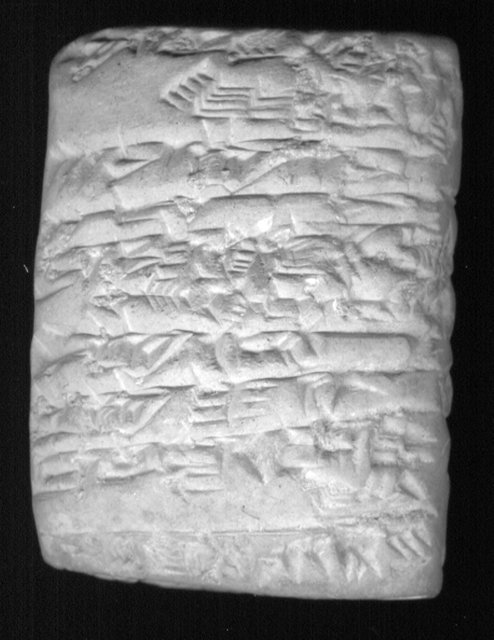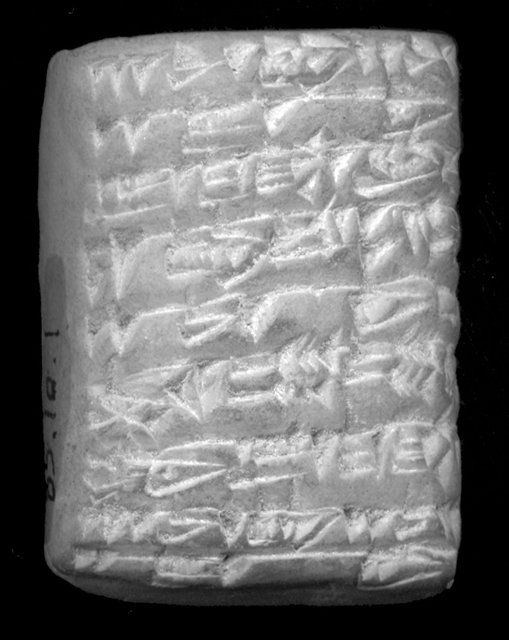A Sumerian Messenger Text in the Kelsey Museum
Skip other details (including permanent urls, DOI, citation information)
: This work is protected by copyright and may be linked to without seeking permission. Permission must be received for subsequent distribution in print or electronically. Please contact [email protected] for more information.
For more information, read Michigan Publishing's access and usage policy.

The Kelsey Museum houses a collection of roughly 600 cuneiform tablets and other objects inscribed with cuneiform writing from ancient Mesopotamia. About 350 of the cuneiform objects were inscribed in Sumerian, one of several languages written in cuneiform script.[1] This was probably the first language written in Mesopotamia; it died out in antiquity and has no known relatives. Most of these tablets date to the time of the Third Dynasty of Ur (also referred to as Ur III, ca. 2112–2004 BCE), one of the best-known periods of Mesopotamian history, documented by tens of thousands of bureaucratic records. Among these is a group of tablets that are commonly labeled as “messenger texts.” The exact definition of messenger texts is still contested among scholars, but generally the term refers to documents pertaining to the expenditure of rations to official messengers, who traveled between Mesopotamia and Iran (Sallaberger 1999).
The Kelsey Museum tablet collection has seventeen of these messenger texts, but only two of them have been published to date.[2] Modern scholars can in many cases reconstruct the provenance of Ur III documents by studying the month names in the text; but in addition the shape and size of the tablet, as well as the personnel and characteristic bureaucratic terms, help identify the origin of a document.
Messenger texts are mainly known from the ancient cities of Girsu and Umma, both located in the southern part of modern Iraq on the route into Iran. Twelve of the Kelsey messenger texts come from Girsu, and five are probably from Umma. The terminology and the types of goods expended differ depending on which site the tablets came from. Messenger texts from Girsu were generally written on small and narrow tablets. They usually are not dated by year but often give the day and month of the transaction described in the tablet.[3]
Here is one of the unpublished tablets at the Kelsey Museum (KM 89013); it is a typical Girsu messenger text:
Text
obverse
- 1. 3 sila3 kaö 2 sila3 ninda
- 2. 2 gin2 i3
- 3. ip-qu2-öa lu2-kas4
- 4. 0.3.0 kaö gen 0.2.0 ninda lugal
- 5. 2 sila3 i3-giö
- 6. NIM du8-du8-li2ki
- 7. giri3 ip-qu2-öa
- 8. 3 sila3 kaö 3 sila3 ninda
- 9. 2 gin2 i3
reverse
- 10. arad2-dnanna ha-za-num2-öe3 gin-na
- 11. 3 sila3 kaö 2 sila3 <ninda>
- 12. 2 gin2 i3
- 13. ur-den-ki sa-bu-umki-ta gin-na
- 14. 0.0.1 kaö sag10
- 15. 0.0.2 kaö 0.0.3 ninda
- 16. ur-dnin-sun2 dumu lugal
- 17. zi-ga u4 18-kam
- 18. iti amar-a-a-si
Translation
obverse
- 1. 3 liters of beer, 2 liters of bread,
- 2. 2 shekels of oil,
- 3. (for) Ipquöa, the runner;
- 4. 180 liters of beer, 120 liters of bread,
- 5. 2 liters of oil,
- 6. (for) the NIM-workers of (the land of) Duduli,[4]
- 7. via Ipquöa;
- 8. 3 liters of beer, 2 liters of bread,
- 9. 2 shekels of oil,
reverse
- 10. (for) Arad-Nanna who went to Hazanum;
- 11. 3 liters of beer, 2 liters of <bread>,
- 12. 2 shekels of oil,
- 13. (for) Ur-Enki, who came from (the land of) Sabum;
- 14. 10 liters of high-quality beer,
- 15. 20 liters of beer, 10 liters of bread
- 16. (for) Ur-Ninsun, the prince;
- 17. Expenditure; the 18th day,
- 18. Month of Amara’asi (10).
The Girsu messenger texts often show rations of beer, bread, and oil given to messengers on their way to and from different regions in the realm of the Ur III state. The Kelsey tablet translated above mentions Sabum, an area that lay east of southern Mesopotamia and is today part of Iran. The tablet is interesting because it mentions Ur-Ninsun, one of the sons of Amar-Su’en (2046–2038 BCE), the third king of the Ur III dynasty. The prince’s rations are much larger than the 3 to 5 liters of beer and bread an ordinary messenger would receive.
A comprehensive study of messenger texts from Girsu is still wanting and would greatly enhance our understanding of Mesopotamian diplomacy and relations with the East. The one messenger text published here and other Sumerian tablets in the Kelsey Museum collection will soon become available online, in digital images and in transliteration, as part of a larger project, the Cuneiform Digital Library Initiative (CDLI) at the University of California at Los Angeles.[5] It is to be hoped that the transliterations will contribute to future studies of this important group of documents.
Notes
The remaining tablets in the Kelsey collection were inscribed in Akkadian, the oldest Semitic language attested. I would like to thank Professor Sharon Herbert, director of the Kelsey Museum, for permission to publish KM 89013 here. I am also grateful to Robin Meador-Woodruff and Sebastián Encina for their assistance in working with the cuneiform tablet collection. I am indebted to Piotr Michalowski and David Owen for their comments on this article.

The published messenger texts are Snell 1979, no. 160 (= KM 89022) and Owen 1991, no. 191 (= KM 89157). Those unpublished are: KM 89013, 89019, 89031, 89034, 89045, 89052, 89054, 89068, 89069, 89070, 89081, 89119, 89172, 89221, 89336.

For studies on messenger texts from Girsu, see McNeil 1970, 62–73; Sigrist 1986; Farber 1997a; Sallaberger 1999 (with additional literature); Capitani 2003, 181–235.

The exact meaning of the term NIM in connection with messenger texts is still not clear. For a recent discussion including older literature, see Farber 1997a, 109 n. 4 (for a copy of the tablet published there, see Farber 1997b).

The Kelsey tablet collection will be accessible at the following Web address: http://cdli.ucla.edu:591/cdli/kelsey/kelsey.html.

Works Cited
Capitani, M. 2003. Girsu Messenger Texts in the British Museum. Nisaba 3. Messina: Dipartimento di scienze dell’antichità dell’Università di Messina.
Farber, G. 1997a. “Von Lagaš nach Tübingen.” In Ana šadî Labnāni lū allik: Beiträge zu altorientalischen und mittelmeerischen Kulturen. Festschrift für Wolfang Röllig, ed. B. Pongratz-Leisten, H. Kühne, and P. Xella, 109–114. Alter Orient und Altes Testament 247. Münster: Ugarit-Verlag.
———. 1997b. “Nochmals ‘Von Lagaš nach Tübingen’.” Nouvelles assyriologiques brèves et utilitaires, article no. 57, p. 53.
McNeil, R. C. 1970. “The ‘Messenger Texts’ of the Third Dynasty of Ur.” PhD dissertation, University of Pennsylvania.
Owen, D. I. 1991. Neo-Sumerian Texts from American Collections. Materiali per il vocabolario neosumerico 15. Rome: Unione academica nazionale.
Sallaberger, W. 1999. “Ur III-Zeit.” In Mesopotamien. Akkade-Zeit und Ur III-Zeit, ed. W. Sallaberger and A. Westenholz, 295–314. Orbis Biblicus et Orientalis 160/3. Freiburg: Universitätsverlag Freiburg; Göttingen: Vandenhoeck & Ruprecht.
Sigrist, M. 1986. “Les Courriers de Lagaš.” In Fragmenta Historiae Elamicae: Mélanges offerts à M. J. Steve, ed. L. de Meyer, H. Gasche, and F. Vallat, 51–63. Paris: Éditions Recherche sur les Civilisations.
Snell, D. C. 1979. The E. A. Hoffman Collection and Other American Collections. Materiali per il vocabolario neosumerico 9. Rome: Multigrafica editrice.

